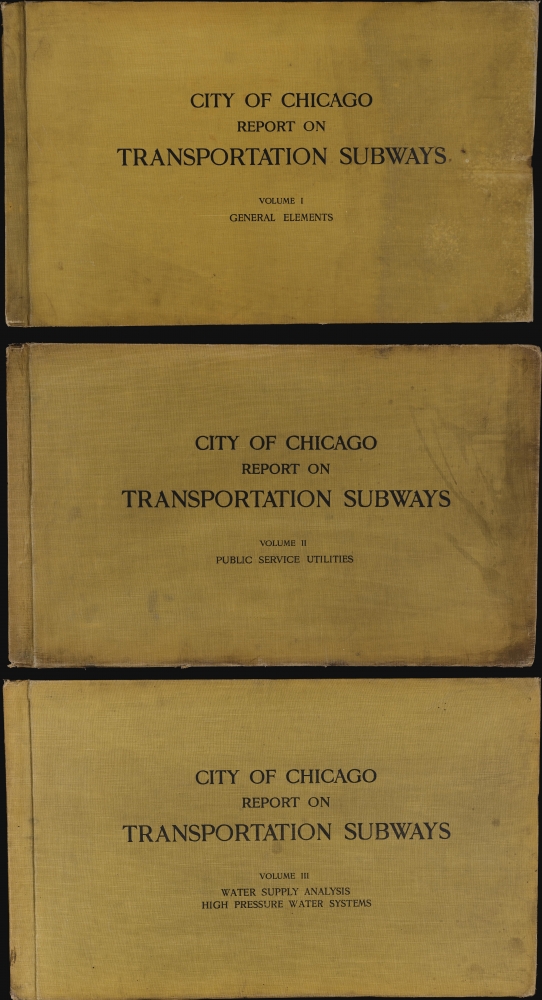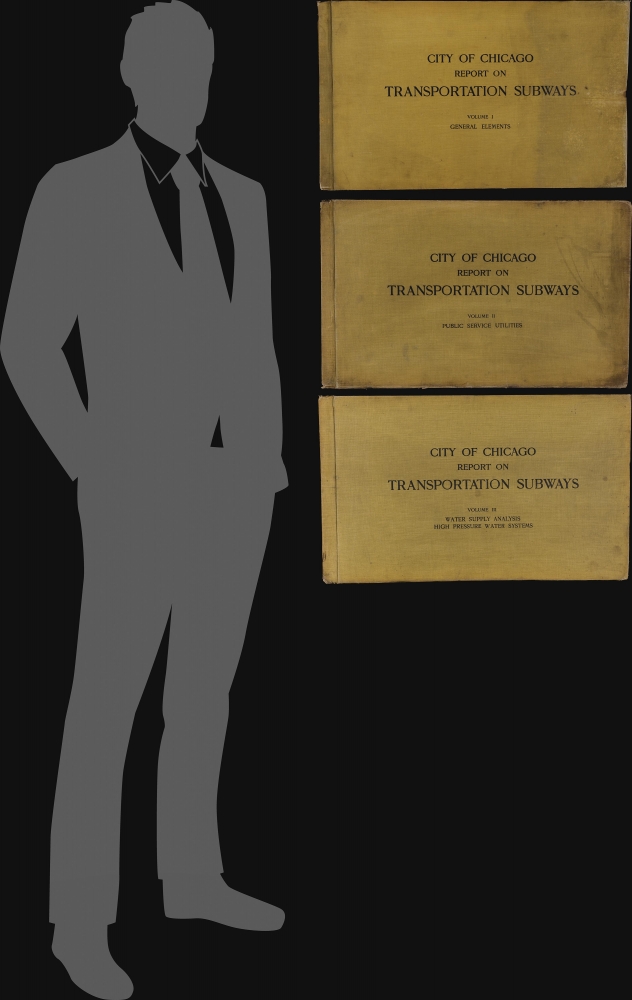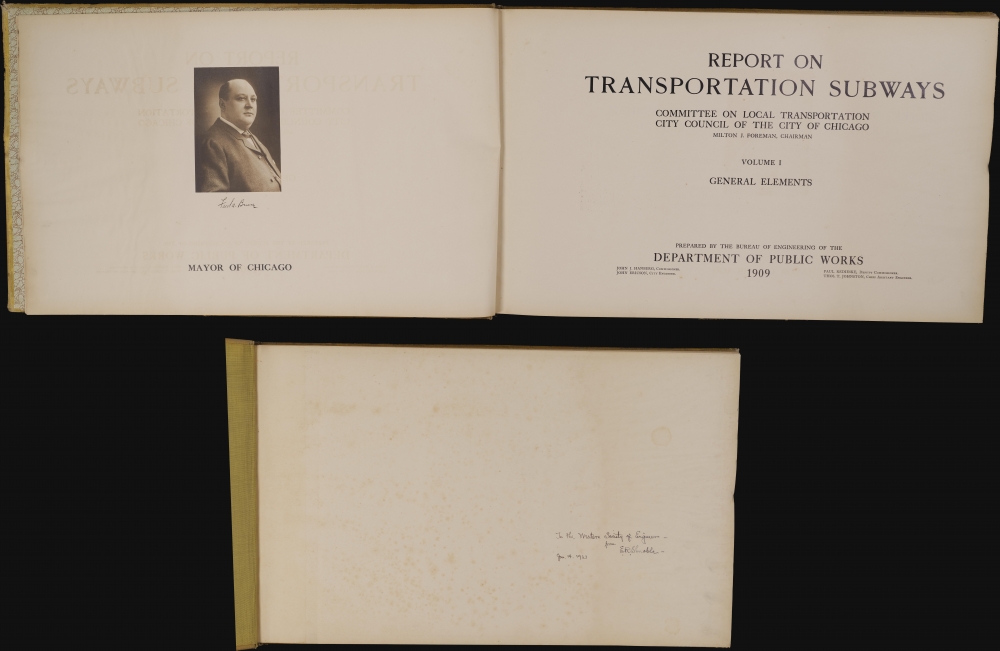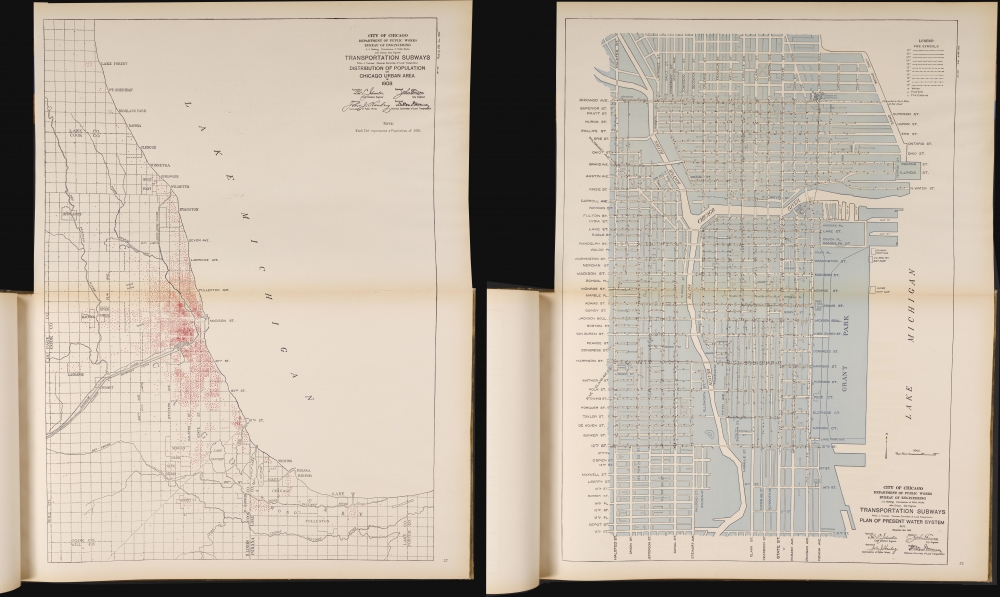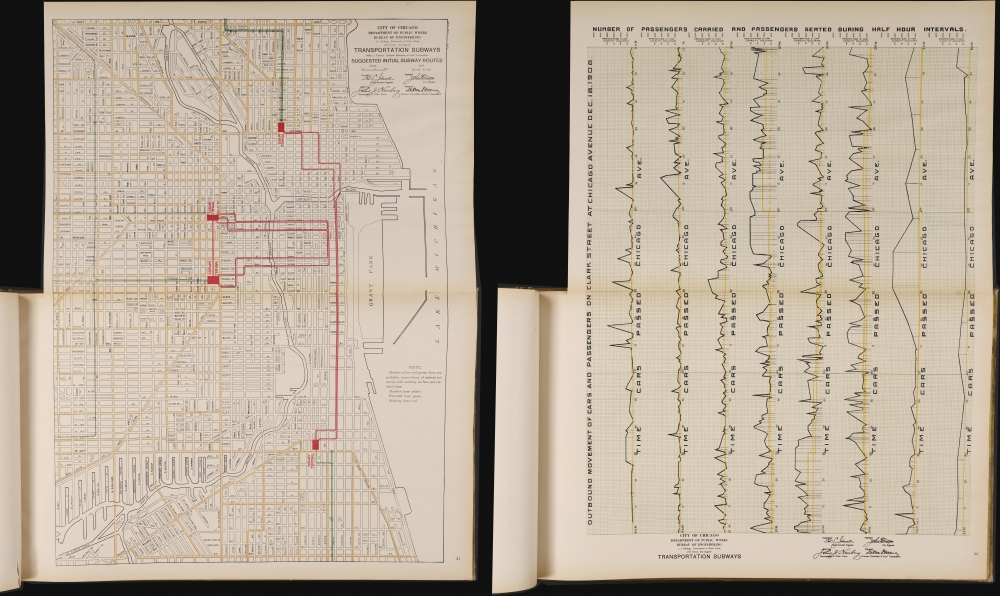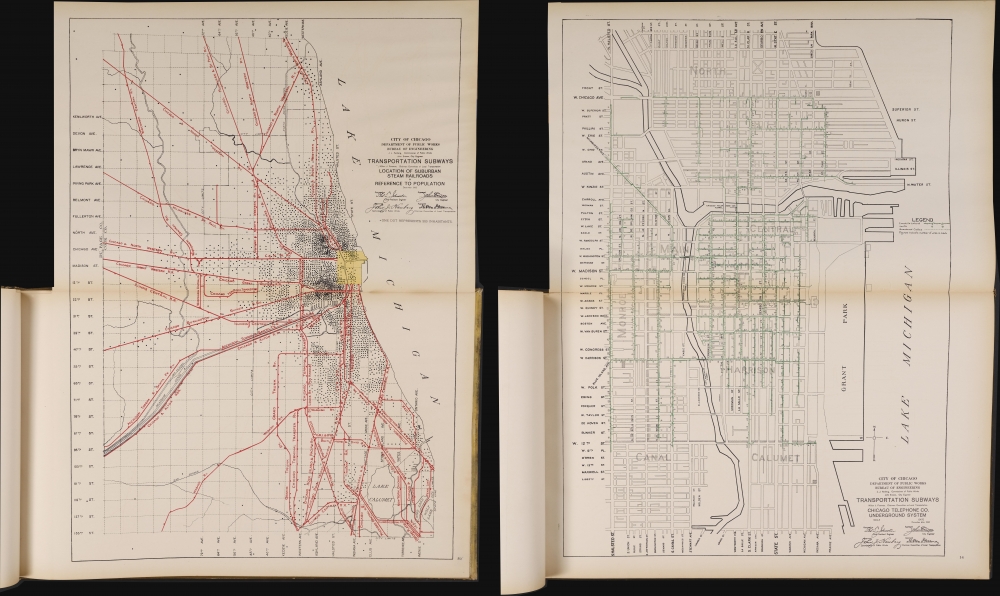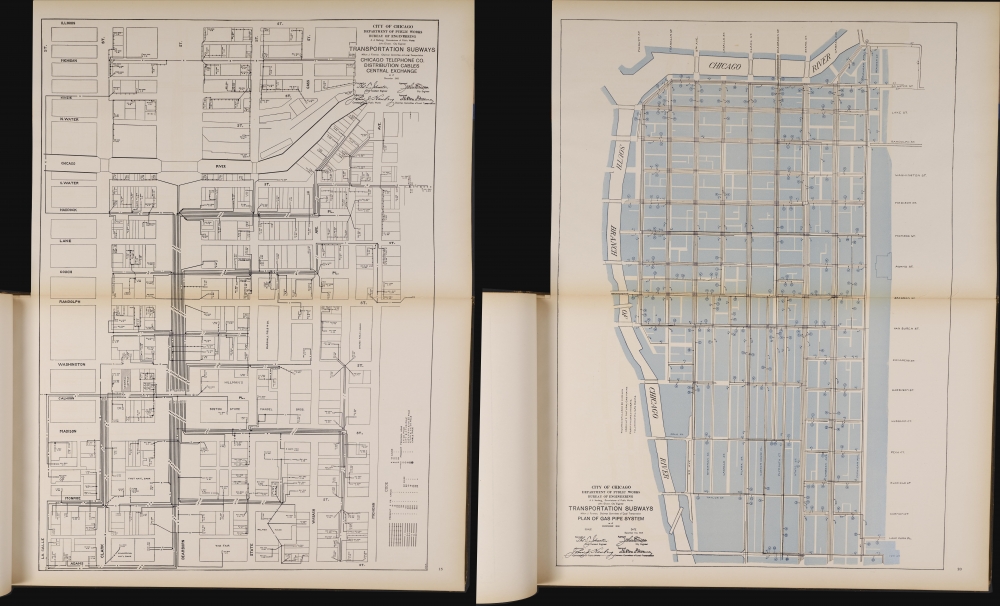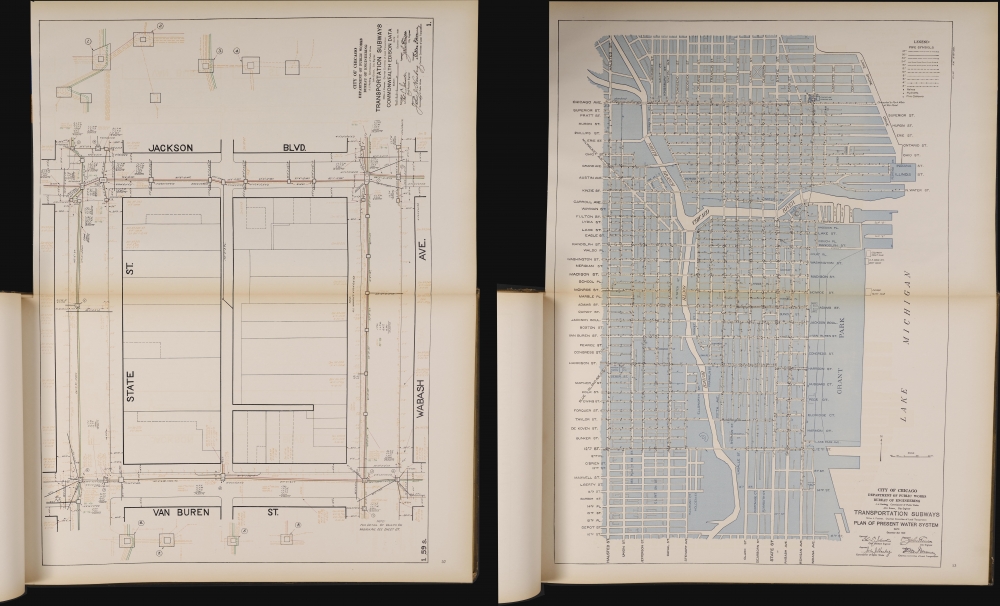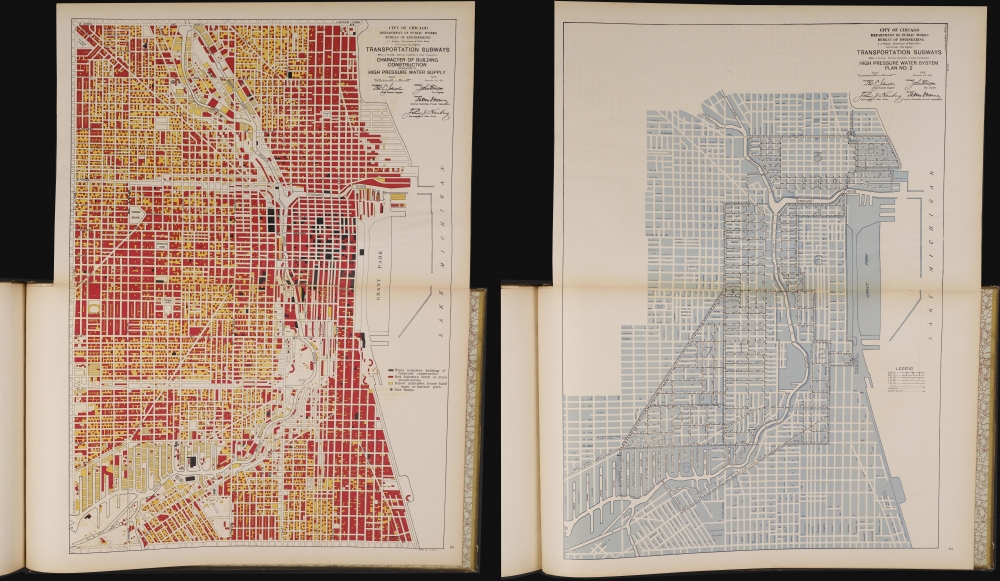1903 3-Volume Study on the the Feasibility of Subways in Chicago
ChicagoSubways-foreman-1909
Title
1909 (dated) 15.75 x 25 in (40.005 x 63.5 cm)
Description
Historical Context
By 1906, Chicago's downtown public transit system was slowly being overwhelmed. Street-level street cars vied with pedestrians, the increasingly popular automobile, and remnant horse-drawn traffic, culminating in gridlock-level congestion. This, experts projected, would only get worse as populations increased and interurban transit networks brought more and more day commuters from the outlying suburban regions.Milton J. Foreman, then a city Alderman, advocated for the construction of several new subway lines comparable to those already operating in New York, Boston, and San Francisco. As early as 1902, Foreman wrote, '… a system of subways for street cars, at least in the congested districts, is essential if Chicago is to have good, comfortable, and rapid transportation.' (Chicago Daily Tribune, August 4, 1902) The city council followed his advice, establishing a 'Committee on Local Transportation', headed by Foreman himself. Through 1908, Foreman and his team compiled the exhaustive study, leaving no stone unturned. This study, offered here, was published in 1909. Two years later, in 1911, Foreman presented a 75-page recommendation for a 'Comprehensive Passenger Subway System for the City of Chicago'. In it, Foreman, describes this study,
information regarding foundations, underground utilities, occupancy of sub-sidewalk space, character of soils, and other difficulties which would be encountered in the construction of subways in the present business district, has been compiled, but it has not been thought best to go to the expense of preparing full detailed construction plans for the various subways discussed until it has been definitely decided by the city just what part of the subway system will first be built. It has, however, been necessary to prepare many general and detailed plans in order to reach the conclusions submitted herewith ...Foreman's plans for new subway lines in Chicago were derailed by the outbreak of World War I (1914 - 1918). Foreman himself returned to military service, becoming a highly decorated officer in three countries. After the war, efforts to resuscitate the plan were repeatedly sidelined. It was not until 1939 that the Public Works Administration facilitated construction on 9 miles of rapid transit subways in Chicago, mostly following Foreman's recommendations.
Outline and Contents.
- Volume 1: General Elements(23 maps, 6 fold-out charts, and numerous technical illustrations including station schematics and engineering diagrams)
This introductory volume outlines the scope, objectives, and foundational methodologies of the study.- A comparative evaluation of established subway systems in major U.S. cities, notably New York and Boston, accompanied by supporting cartographic materials.
- An analytical overview of Chicago's demographic trends and existing public transportation infrastructure, featuring detailed charts and forecasts of projected ridership by transit line. This section also introduces the municipal water system, which would be significantly affected by new subway construction.
- A technical examination of subsurface conditions in Chicago, including soil composition, street construction techniques, and the structural foundations of existing buildings.
- Volume 2: Public Service Utilities(29 maps and extensive technical diagrams)
This volume presents a comprehensive assessment of current and anticipated underground utility systems.- An exhaustive survey of subterranean infrastructure, including sewerage, freshwater supply, high-pressure water lines, gas mains, and telecommunications (telephone, telegraph, and electrical lines).
- A focused analysis of sub-sidewalk space utilization—such as basements, storage areas, and mechanical rooms—along primary corridors impacted by the proposed subway network, including Michigan Avenue, Wabash Avenue, Fifth Avenue, Clark Street, State Street, Dearborn Street, and Adams Street.
- A structural review of existing bridges and tunnels, evaluating their integration with and potential impact on the proposed subway system.
- Volume 3: Water Supply and High-Pressure Systems(11 maps and a variety of engineering diagrams)
This volume is divided into three specialized sections.- A thorough analysis of the city's water supply infrastructure, supported by detailed maps and technical illustrations.
- An evaluation of high-pressure water systems for fire suppression. Although such a system was not yet implemented in Chicago, this section offers comparative insights from fire-prone cities such as Philadelphia, New York, and San Francisco.
- A proposed implementation plan for a high-pressure fire protection system modeled after San Francisco's, with a meticulously calculated projected cost of $3,395,415—an impressively economical figure by contemporary standards.
Publication History and Census
This 3-volume report was compiled by Milton J. Foreman, Chairman of the Chicago City Council Committee on Local Transportation. It was printed in March 1909 by R. R. Donnelley and the Lakeside Press, Chicago. We see 10 holdings of the original printed work cataloged in OCLC, curiously, none in Chicago. Another 33 entries note examples preserved on microfilm. The present example has provenance to the Western Society of Engineers. No market history.Cartographer
Milton Joseph Foreman (January 25, 1863 - October 16, 1935) was a Chicago-based lawyer, military officer, reservist, and politician active in the late 19th and early 20th centuries. Foreman enlisted in the Illinois National Guard (Troop C) in 1894. He later joined the First Illinois Calvary, in which he served as a captain and quartermaster of his regiment in the Spanish-American War (April 21 - August 13, 1898). After achieving the rank of Colonel, he transferred to the reserves and entered the private sector. He received a law degree in 1899 and was a senior partner with law firm Foreman, Bluford, Steel and Schultz. He also served six terms on the city council of Chicago from 1899 - 1911. Also in Chicago, he completed a meticulous engineering study of Chicago in anticipation of building a subway there - a project that was delayed for decades by the outbreak of World War I (1914 - 1918). He returned to active duty by, at least, 1915. His calvary regiment was converted to Artillery, becoming the 122nd Field Artillery, 33rd Division. He was highly decorated during the war. He received the Distinguished service cross and medal, the French Legion of Honor, and the Belgian Commander Couronne. After the war, he was assigned to command the 33rd Division Illinois National Guard, with the rank of Major General. He retired from service in 1927. More by this mapmaker...

